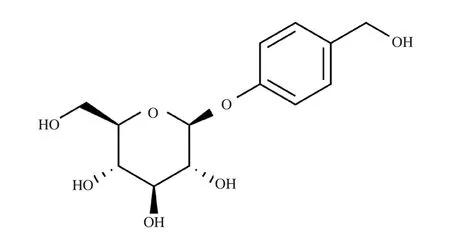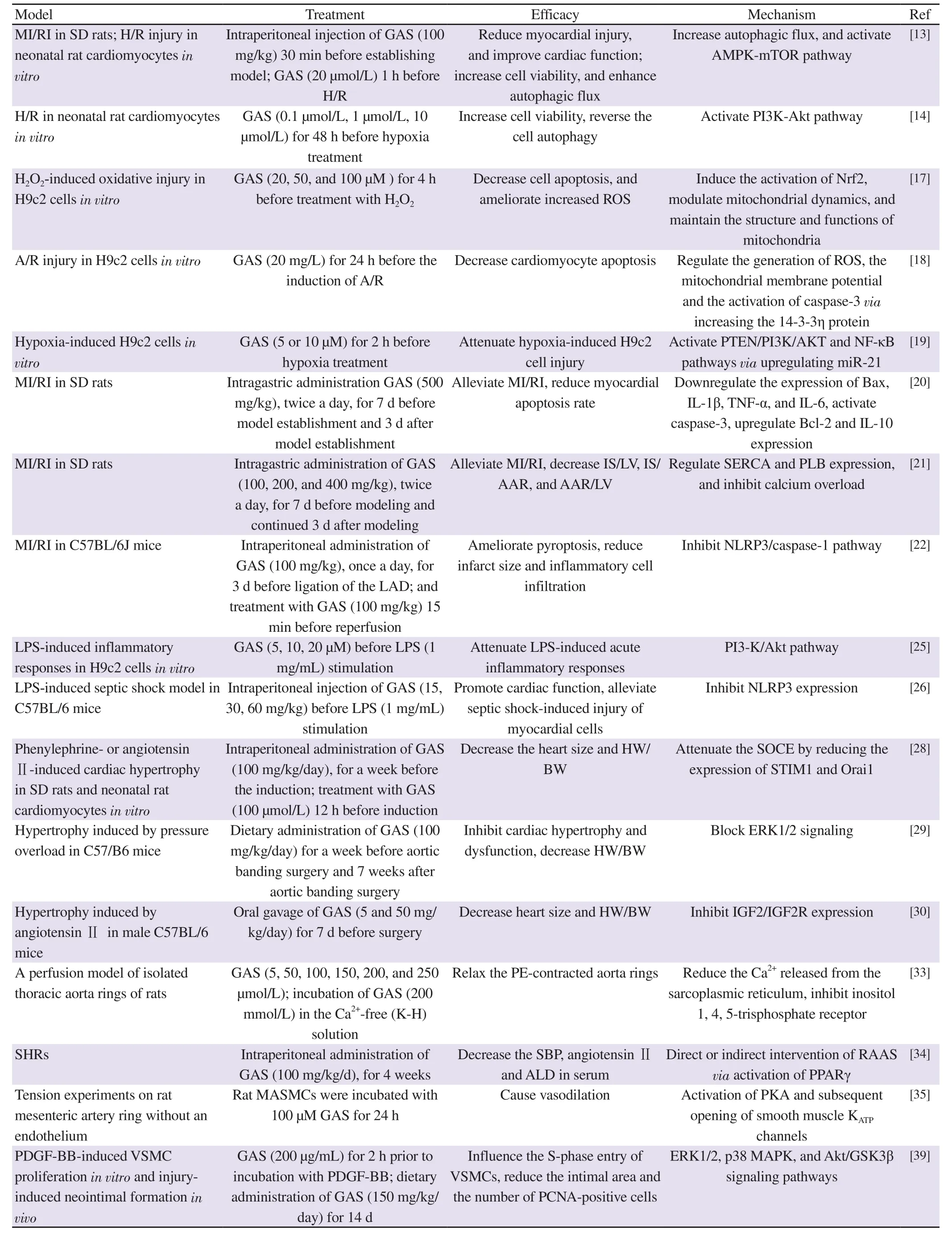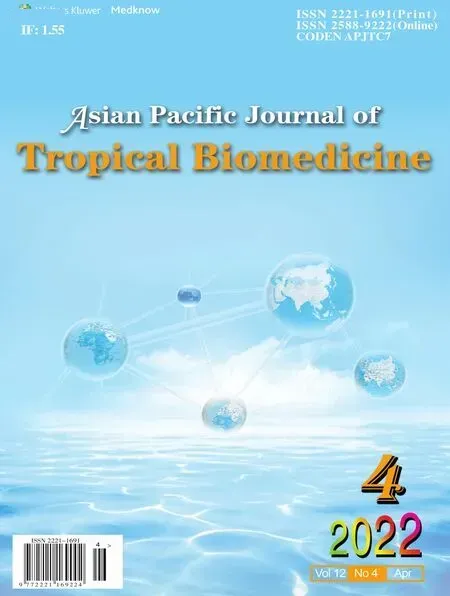Cardiovascular protective properties of gastrodin
Shu-Ting Yang, Shu-Bai Liu
1School of Life Sciences, Yunnan University, Kunming 650091, Yunnan, China
2State Key Laboratory of Phytochemistry and Plant Resources in West China, Kunming Institute of Botany, Chinese Academy of Sciences, Kunming,650201, Yunnan, China
ABSTRACT
Cardiovascular diseases cause significant morbidity and mortality worldwide, incurring a major public health burden. Gastrodia elata Blume is a traditional Chinese herbal medicine that has been widely used to treat central nervous system and cardiovascular diseases.Gastrodin, as the major active component in Gastrodia elata Blume,can confer protection against cardiovascular diseases. In this review, we summarize the anti-inflammatory actions, anti-cardiac hypertrophy, anti-hypertension, anti-atherosclerosis, and angiogenic effects of gastrodin, as well as its protective effects on vascular cells and against myocardial ischemia‐reperfusion injury. The medical potential of gastrodin in diabetes-related cardiovascular diseases is also discussed.
KEYWORDS: Gastrodin; Cardiovascular diseases; Myocardial ischemia-reperfusion injury; Gastrodia elata Blume; Antiatherosclerosis; Cardio-protection
1. Introduction
Cardiovascular diseases (CVDs) are a category of disorders caused by chronic inflammation, oxidative stress, and thrombosis.They are one of the main causes of death globally. They can also lead to more serious health problems such as stroke, myocardial infarction, and ischemia/reperfusion (I/R) injury[1,2]. Herbal monomer is gaining popularity due to its multitargeted benefits and low toxicity[3-5]. Tian ma, the dried rhizomes of Gastrodia elata Blume, is a well-known and valuable traditional Chinese herb with a long history of clinical application for central nervous system and cardiovascular issues[6]. Gastrodin (4-hydroxybenzyl alcohol-4-O-β-D-glucopyranoside, Figure 1) is a major active component of Tian ma in recent pharmacological investigations, as well as one of the phytochemical markers of Tian ma in the Chinese Pharmacopeia (2020 version)[7,8]. Gastrodin possesses a wide range of pharmacological benefits, including sedative, anticonvulsive, anti-vertigo, anti-epileptic,anxiolytic, enhancing learning, anti-aging, and anti-hypertensive effects,and can be used to treat neurasthenia[6,9,10]. Nonetheless, previous researches have mostly focused on the treatment of neurological illnesses, severely underestimating the effects on CVDs.

Figure 1. Chemical structure of gastrodin.
In this review, we summarized the pharmacological effects of gastrodin on CVDs to better understand its cardiovascular benefits and its mechanisms of action (Table 1). The relevant literature was retrieved from electronic databases, such as Web of Science,PubMed, and CNKI from April 1980 to December 2021, by using keywords of gastrodin and cardiovascular diseases.
2. Cardiovascular protective effects of gastrodin
2.1. Cardiac protective effects
2.1.1. Protection against hypoxic injury and myocardial ischemia-reperfusion injury (MI/RI)
Restoring blood flow is generally considered to be an effective therapeutic approach for ischemic heart diseases. While providing fresh blood to the ischemic myocardium, the myocardial ischemiareperfusion also exacerbates cardiac dysfunction and myocardial cell damage. This pathophysiological feature is known as MI/RI,and treating ischemic heart diseases is still difficult. Therefore, new effective methods for preventing and treating myocardial ischemia are urgently needed[11,12].
The cardiac protective effects of gastrodin have been studied using animal models and cell cultures. By boosting autophagic flux, pretreatment with gastrodin (100 mg/kg, i.p.) reduced defective mitochondria and myocardial infarct size in a MI/RI rat model. Further in vitro tests revealed that the cardiac protective effects of gastrodin were mediated via phosphorylation of the mammalian target of rapamycin (mTOR) and AMP-activated protein kinase (AMPK)[13]. Gastrodin has also been shown to modulate autophagy, alleviate H/R injury, and improve proliferative activity in cardiomyocytes through the activation of mTOR signals in the PI3KAKT-mTOR pathway[14].
The pathogenic factors of cardiac I/R injury are complicated by cardiac microcirculation disruption and endothelial dysfunction.Furthermore, mitochondria have been implicated in the pathogenesis of most cardiovascular disorders, which entail signaling regulation in the heart microcirculation. Mitochondrial dynamics are disrupted during reperfusion of cardiac ischemia, with increased fission,reduced fusion, and impaired mitophagy. The vascular tone,inflammation, microvascular patency, viability, and mobility of endothelial cells are all affected by mitochondrial abnormalities,culminating in cardiac reperfusion injury[15,16]. Gastrodin (20, 50,and 100 μM) was found to significantly enhance cell viability in H9c2 cells with H2O2-induced oxidative damage. It has the potential to prevent apoptosis by activating Nrf2, modifying mitochondrial dynamics, and maintaining mitochondrial structure and function[17].Gastrodin reduced caspase-3, creatine phosphokinase, and lactate dehydrogenase activity in another investigation by increasing 14-3-3η protein levels. Gastrodin (20 mg/L) can also restrict the opening of the mitochondrial permeability transition pore, reduce reactive oxygen species production, and change the maintenance of the mitochondrial membrane potential (ΔΨm), thus providing significant protection against A/R injury[18].
Aside from the mechanisms of action outlined above, other processes contribute to the protective effects of gastrodin against MI/RI or hypoxic injury. Gastrodin at 5-10 μM was found to ameliorate hypoxia injury in H9c2 cells by up-regulating miR-21 and activating the PTEN/PI3K/AKT and NF-κB pathways in vitro[19].In addition, gastrodin (500 mg/kg/twice a day, i.g., for 7 d before model establishment and 3 d after model establishment) reduced myocardial apoptotic rate in a MI/RI rat model by downregulating Bax, activating caspase-3 expression and upregulating Bcl-2 expression[20]. Gastrodin (100, 200, and 400 mg/kg/twice a day, i.g., for 7 d before modeling and 3 d after modeling) dose‐dependently reduced the ratio of heart weight to left ventricular weight in rats, alleviating MI/RI and inflammation-induced injury. The cardioprotective effect was mediated by inhibition of calcium overload and regulation of sarcoplasmic reticulum calcium transport ATPase and calcium phosphate expression in the sarcoplasmic reticulum[21]. During myocardial I/R, gastrodin exhibited noticeable capillary formation,anti-inflammatory and anti-pyropthotic effects on microvascular injury via the NLRP3/caspase-1 pathway[22].
2.1.2. Inhibitory effect on the inflammatory responses
In severe sepsis/septic shock, septic cardiac dysfunction could be induced by the bacterial endotoxin lipopolysaccharide (LPS). Proinflammatory mediators and cytokines play significant roles in sepsis-associated myocardial dysfunction. Therefore, protecting myocardium cells from inflammatory responses appears to be a promising approach to reduce mortality in sepsis patients with cardiac dysfunction[23,24]. A previous study showed that gastrodin could lower the expression of inducible nitric oxide synthase,cyclooxygenase-2, tumor necrosis factor-α, and interleukin-6, and suppress the activation of nuclear factor-κB and mitogen-activated protein kinases family. The anti-inflammatory effect of gastrodin against septic cardiac dysfunction could be mediated via activation of PI3K/Akt pathway[25]. Another study also revealed that the lower expression of NLRP3 plays a major role in the treatment of septic shock-induced injury with gastrodin[26].
2.1.3. Anti-cardiac hypertrophy
Pathological cardiac hypertrophy is frequently associated with cardiac dysfunction, which increases the risk of heart failure.Furthermore, the evidence implies that reducing stress-induced cardiac hypertrophy is a beneficial treatment for heart failure[27].In C57 mice with phenylephrine‐induced myocardial hypertrophy,gastrodin (100 mg/kg/day, i.p., for a week) dose‐dependently inhibited myocardial hypertrophy by lowering the heart size and ratio of heart weight to body weight. Its action on Orai1 and STIM1 expression, as well as modulation of SOCE (store-operated Ca2+entry) were related to cardio-protection[28]. Gastrodin (100 mg/kg/day,p.o., for 8 weeks) suppressed the expression of cardiac hypertrophy markers including atrial natriuretic peptide, B-type natriureticpeptide (BNP), and myosin heavy chain 7 via the ERK1/2 signaling pathways, thus showing the protective effects on pressure-induced cardiac hypertrophy[29]. Furthermore, insulin-like growth factor type 2 and its receptor have been identified as a key potential target in the treatment of angiotensin Ⅱ-induced cardiac hypertrophy with gastrodin based on bioinformatics analysis[30].

Table 1. Cardiovascular protective effects of gastrodin.

Table 1. Cardiovascular protective effects of gastrodin (continued).
2.2. Vascular protective effects
2.2.1. Hypotensive effect
Hypertension is a chronic disease that has a significant negative impact on people’s health. It can lead to serious health consequences such as myocardial infarction, stroke, renal failure, coma, and even death if unproperly treated[31,32]. Gastrodin has been exhibited to have significant vascular relaxing effects on thoracic aorta rings of rats, mainly inhibiting the sigaling of inositol 1, 4, 5-trisphosphate receptor in the sarcoplasmic reticulum[33]. Meanwhile, gastrodin(100 mg/kg/d, i.p., for 4 weeks) reduced systolic blood pressure levels in spontaneously hypertensive rats (190.2 ± 8.9 versus 169.8± 6.4). The antihypertensive properties of gastrodin were achieved directly or indirectly through intervening with the renin-angiotensinaldosterone system[34]. Moreover, gastrodin produced vasodilation in rat mesenteric artery rings through opening smooth muscle KATPchannels and activating protein kinase A[35].
2.2.2. Protection of vascular cells
Multiple growth factors and cytokines stimulate the proliferation of vascular smooth muscle cells, which is the frequent pathological process in many cardiovascular diseases, such as arteriosclerosis and restenosis following vein grafting or coronary intervention[36-38].Gastrodin has been shown to reduce the proliferation of vascular smooth muscle cells in vitro and suppress neointimal hyperplasia in vivo. Inhibition of ERK1/2, p38, and Akt/GSK3β signaling was partially responsible for the protective effect of gastrodin[39].Gastrodin also significantly reduced homocysteine-induced injury in human umbilical vein endothelial cells, which could be associated with the regulation of PI3K/Akt/eNOS and Nrf2/ARE pathways[40].
2.2.3. Anti-atherosclerosis effects
Myocardial infarction and stroke are both caused by atherosclerosis,which is a major risk factor of acute cardiovascular events. It has been linked to chronic inflammation and lipid dysbolism[41].Gastrodin (50, 100, and 200 mg/kg, p.o., for 20 weeks) reduced the levels of blood lipid and inflammatory factors in C57BL/6J mice through remodeling intestinal flora[42]. Another study found that gastrodin inhibited the development of foam cells in murine macrophage cells, indicating that it has significant antiatherosclerosis properties[43].
2.2.4. Angiogenic effects
Angiogenesis is an effective treatment for various CVDs that aims to improve the function of ischemic tissues by increasing blood supply[44]. In both in vivo and in vitro studies, gastrodin exhibited prominent angiogenic effects. Gastrodin (10 and 25 μM) could improve cell proliferation, migration, and tube formation in human umbilical vein endothelial cells by activating the PI3K/Akt signaling pathway[45]. The network pharmacologic analysis revealed that gastrodin has a significant correlation coefficient with proangiogenic activity in an animal model[46]. Furthermore, gastrodin has been shown to increase the survival rate of flaps (random pattern), which is linked to the promotion of angiogenesis[47].
3. Conclusion
Some Chinese herbal medicines containing Tian ma have been widely used to treat CVDs in clinical practice. Gastrodin has long been regarded as an intriguing and promising active molecule because it is a major ingredient of Tian ma. With the advancement of synthesis technology[48-50], it is expected that gastrodin will continue to have a high value in medical applications.
Cardiovascular problems are the leading cause of mortality in diabetes patients. Diabetes mellitus promotes the risk of peripheral vascular disease, heart failure, and ischemic stroke. In the overall management of diabetes mellitus, there is substantial unmet demand for cardiovascular prevention[51-53]. Gastrodin had a protective effect on myocardial cells in a high glucose-induced cell damage model[54]. Gastrodin has also been shown to reduce cognitive dysfunction and retinopathy, two typical consequences of diabetes,by maintaining vascular function[55,56]and have significant effects in the treatment of type 2 diabetes mellitus[57]. Therefore, these results could imply that gastrodin with cardiovascular protective properties could be useful in the prevention and management of diabetes and its associated diseases.
Gastrodin has long been known for its ability to treat illnesses of central nervous system diseases[9,58,59]. Nonetheless, we highlight gastrodin as a promising therapeutic candidate for the prevention and treatment of CVDs in this review. As previously stated, gastrodin protects against CVDs primarily through ERK1/2, AMPK-mTOR,PI3K-AKT, NF-κB, and Akt/GSK3β pathways, etc. Furthermore, we also discussed the medical potential of gastrodin in diabetes-induced CVDs. Thus, gaining a better knowledge of these mechanisms may provide new directions for the development of therapeutic approaches in the treatment of CVDs. More detailed mechanisms,on the other hand, will necessitate further investigation.
Conflict of interest statement
The authors declare that there is no conflict of interest.
Authors’ contributions
STY conceived and composed the article. SBL critically reviewed and revised the final draft of the article.
 Asian Pacific Journal of Tropical Biomedicine2022年4期
Asian Pacific Journal of Tropical Biomedicine2022年4期
- Asian Pacific Journal of Tropical Biomedicine的其它文章
- Methyl gallate isolated from Mangifera pajang kernel induces proliferation inhibition and apoptosis in MCF-7 breast cancer cells via oxidative stress
- Anti-obesity effect and UHPLC-QTOF-MS/MS based metabolite profiling of Solanum nigrum leaf extract
- Analgesic-like activity of perillyl acetate: In vivo and in silico studies
- Lipid-lowering effect of Oroxylum indicum (L.) Kurz extract in hyperlipidemic mice
